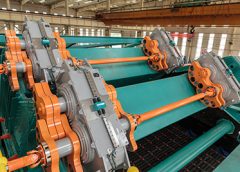Vibrating machines such as screens and feeders are used at almost every mine site to classify and convey bulk materials that have been extracted. The machines churn through tons of material and are integral to the successful operation of mining sites. Therefore, valuable information that drives the efficient operation of these assets is constantly created.
The challenge is that extracting this information involves deciphering cryptic and complex motion raw data, a job that can only be done by the most elite domain and data experts. So, what if this intricate process could be predominantly achieved through artificial intelligent (AI) algorithms?
Schenck Process’ research and development team in Germany, led by Jan Schäfer, is using diverse data mining technologies to solve classification and time series extrapolation problems to create such AI algorithms, signifying a breakthrough in the monitoring of vibrating machines.
Some of the most important information used to maximize the efficiency of vibrating machines fall into two categories:
- Performance parameters that include the total loads, distribution of bulk material and speed.
- Condition parameters, which Schäfer emphasised is a “cost-saving preventive maintenance strategy,” which for the most part is hidden.
Schäfer insisted that the concealment of this information is leading to significant unused cost-saving opportunities that mining companies are missing out on. “Our customers’ plants handle very high throughputs, within every hour they are producing millions of dollars’ worth of material, so there is potential that major costs could occur for processes that are forced to shut down if a problem with machinery is not detected,” he explained. “Condition monitoring finds the problem before they become failures; therefore, preventative maintenance saves significant costs.”
Condition-Based Maintenance
Schäfer explained the importance of condition-based maintenance having the capabilities of taking action on a problem as soon as it’s noticed – the equation is simple. “If you replace the right component at the right time, you can save substantially on maintenance costs,” he said.
It is widely known that most performance and condition parameters correlate with a vibrating machine’s motion pattern. Various industrial sensors that measure the acceleration of the vibrating body are therefore used to capture the motion of a vibrating machine.
While the intricate data being produced by these accelerometers is currently given to a data specialist, Schenck Process has developed AI algorithms to process accelerometer raw data and output specific information.
Given the scarcity of these data experts, the algorithms offer a huge opportunity to mining companies, essentially creating the need for humans to decipher this immensely complicated data obsolete.
“The experts who eventually get that data are rarely available, our customers don’t have these people,” Schäfer explained. “These algorithms enable customers to use the same possibilities system as we do, we can make it available to them.”
AI Learning and Human Expertise
Schenck Process has found that a combination of using AI learning and human domain expertise allows vibrating machines to achieve an optimum level of reliability and accuracy. To achieve this learning, Schäfer presented the “solution approach,” which is based on a technical framework that is coined the “object-based training library.” It allows AI algorithms to constantly learn and develop in order to adjust to a wider range of situations.
“If you want to transfer data to information, you need to develop knowledge – the process to generate knowledge though, is complicated, so we started a library where we archive historic data,” Schäfer said. “Think about all datasets as an experience, which we collect into the database, we label and structure the data.”
Labelling data is crucial for what Schäfer describes as “data mining,” a key process of finding data to then generate knowledge. This is all done by saving and archiving data and then developing apps to explore said data.
“It’s an efficient way to create AI and maintain it so as soon we obtain new data, we are updating the algorithm,” Schäfer said. “Each data that we put in creates a new experience and can consequently optimize your parameters.”
For many, the concept of removing humans completely from the process is frightening, however, this is not what Schäfer is suggesting, instead emphasizing that both AI and humans each bring their own benefits.
While Schäfer admits the AI algorithms won’t be perfect in the first stage of use. Within five years he hypothesizes, however, that human interaction will be less required and as algorithms evolve, so will autonomism.
Schenck Process, www.schenckprocess.com/uscess.com/us

